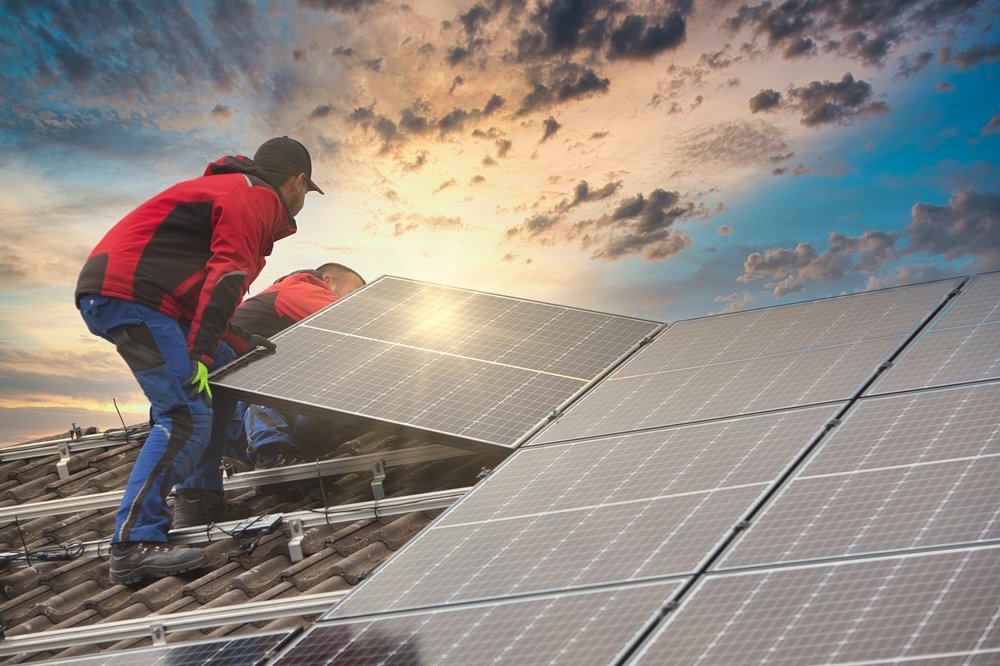In an attempt to further fuel the booming photovoltaic market, the Ministry of Economics has held out the prospect of affordable subsidised loans to homeowners through KfW. However, it turns out that for many average citizens this offer exists only in theory, as they basically have to finance the energy transition themselves. (N-TV, 29.05.2023)
A few weeks ago, Economics Minister Robert Habeck presented his strategy on photovoltaics, which boiled down to one clear message: “We need more speed in the expansion of solar energy.” This statement reflects the current thoughts of many homeowners. In view of continuing inflation, the war in Ukraine and rising energy costs, many are considering buying a photovoltaic system. Using solar energy from one’s own roof can often reduce energy costs by at least half.
German suburbs are currently experiencing an extraordinary solar boom. Manufacturers of photovoltaic systems are inundated with enquiries. Anyone currently enquiring about an installer is often lucky if there are any tradesmen available at all within a year. But the path to energy autonomy turns out to be fraught with hurdles for many homeowners. It is not only long waiting times, delivery problems with solar panels from China and a lack of craftsmen that disappoint many prospective buyers. Additional trouble is caused by the question of how to secure financing for their rooftop power plants.
Solar energy subsidy programme remains out of reach for many homeowners despite possible savings
A solar system with storage for a standard single-family home (10 kWp) can easily cost 30,000 euros, and an energy efficiency modernisation loan could currently cost about 5.5 percent interest annually. To address this, the Kreditanstalt für Wiederaufbau (KfW) has launched the 270 promotional programme. This programme offers companies, freelancers and private households subsidised loans for investments in biogas plants, wind turbines or solar power plants. In the most favourable case, the interest on a KfW loan could currently be just over four percent. Calculated over the usual loan term of ten years, this could save thousands of euros compared to a regular bank loan.

Image: Shutterstock
Despite these potential savings, many homeowners do not benefit from the KfW programme. It seems to exist only on paper for many average consumers. One bank advisor confirms: “We’ve never had this programme before.” Among the more than 500 financial institutions he works with, not a single one offers the KfW 270 promotional loans – neither Sparda-Bank, DSL-Bank, Commerzbank, DKB, Bausparkasse Schwäbisch Hall, nor many larger savings banks and Volksbanks. One possible reason is that the programme could be uneconomical for the banks. “The administrative costs make it uneconomical for the banks,” says the bank advisor.
Non-discriminatory KfW funding on paper, but in reality homeowners struggle with obstacles
In a response to enquiries, Kreditanstalt für Wiederaufbau (KfW) emphasises that “all the target groups mentioned are eligible to apply in the same way” and that there is no discrimination on KfW’s part. However, this is of little use to most potential applicants. Ultimately, the decision-making powers lie with the financial institutions where the applications are submitted, not with the state promotional bank. KfW even admits that “now and then there are problems when applying for KfW funding, especially for small-volume loans”. The advice given to potential solar energy applicants sounds almost cynical: they are advised to “be persistent and, if necessary, present their project again”.
In fact, the photovoltaic forums are filled with frustrated homeowners who don’t even get around to submitting a single application. “The banks often don’t fancy it because it’s cumbersome and not lucrative for them. That’s what happened to me with my house bank, which didn’t want to give me the Kfw270 interest rate despite top credit rating,” one user complains, according to N-TV. Another writes: “Our financing partner told us we wouldn’t find a bank that would go along with it because the amount was too small and the commission for the banks that broker the KfW products was too low.”
KfW also emphasises that “it is not necessary for the applicant to already have a business relationship with the selected financing partner”. In practice, however, many banks impose precisely this as a condition to ensure their profitability. For example, an advisor of a large German commercial bank told a client in writing: “We can only accompany these KfW loans for existing clients with a currently registered land charge and ongoing loan commitment.” Or the representative of an East German savings bank stating that existing real estate financing for the house is necessary in order to apply.
Large investors benefit most from KfW’s solar funding – ordinary consumers fall by the wayside
The Kreditanstalt für Wiederaufbau’s (KfW) own statistics reveal that its funding programme is not distributed fairly. Only about 2.1 billion euros were invested in the expansion of solar systems through the programme last year. An unbelievable 80 percent of this sum went to just 400 large-scale projects: Ground-mounted photovoltaic systems with an average loan amount of 4.2 million euros. And KfW also seems to have little focus on the average consumer when it comes to promoting solar power on roofs: Here, the average funding amount was still more than 75,000 euros, but KfW cannot specify on request how many regular homeowners this might include. It only confirms that in its entire programme – including the promotion of solar, wind and biomass energy – 60 percent of the approvals were above 25,000 euros.
“KfW has no branches where you could apply for the loans directly. Therefore, they can talk a lot when the day is long. But as long as no one grants them, the promotional programme doesn’t exist de facto. They can get their heads around that,” the bank advisor comments to N-TV.
These facts are a sobering reality check for Robert Habeck’s solar strategy. They suggest that large investors, who have sufficient funds anyway, will take the lion’s share of government support. Unfortunately, the least financially positioned players in the Energiewende receive the least support and have to bear virtually all of the costs themselves. To achieve his ambitious goals – an annual addition of 22 gigawatts of capacity – the minister should triple the pace of expansion. The declared goal is that a large part of the total expansion should take place on existing roof surfaces. So Habeck needs the support of homeowners. But so far he has practically nothing to offer in return.






